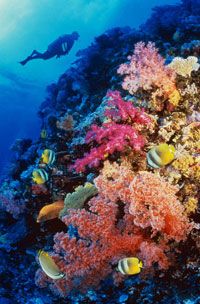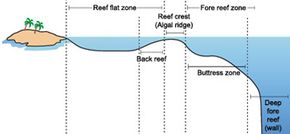Coral Reef Zones
All coral reefs have distinctive horizontal and vertical zones created by differences in depth, wave action, current movement, light, temperature and sediment along different parts of the reef. Although the exact characteristics of each zone may vary slightly depending on the location and type of reef, all reefs have a fore reef, or seaward slope, and a back reef. The back reef is the part of the reef closest to shore, while the fore reef is farther out to sea.
If you were scuba diving and swimming away from land, you first would encounter the reef flat, a relatively shallow zone of the back reef located closest to the shore. The flat's shallow waters experience wide variations in temperature and salinity and contribute to the accumulation of sediments. These factors, along with occasional exposure during low tides, tend to limit coral growth on this section of the reef. Despite the scarcity of coral, this section supports the most species in the entire reef ecosystem. Clams, oysters, worms, crabs and lobsters dominate. Depending on the type of reef, the reef flat may be anywhere from 33 yards (30 meters) to several thousand yards in length.
Advertisement

The reef flat has little coral but its shallow waters teem with life.After you marveled at the marine life in the reef flat, you'd notice the reef starting to slope upward, forming the reef crest. As the highest point of the reef this zone is also exposed at low tide. Unlike the reef flat, however, it is on the outer side of the reef, so it receives the full brunt of the waves. Encrusting algae are prevalent here, busy repairing the constant damage caused by the waves. Where the waves are tamer, strong branching corals grow closely together to better tolerate the crashing seas. Marine animals take shelter in the crevices of the crest, which usually spans between 3 yards and 55 yards (2.7 meters and 50 meters) [source: NOAA].
If you crossed over the crest and headed farther out to sea you would enter the buttress zone, which falls on the outer part of the fore reef. If you were looking to see some sharks or barracudas during your dive, this would be the zone to spot them. The coral reef here is characterized by spurs, or buttresses, of coral that jut out from the wall. In between the spurs are deep grooves, or channels, that help to mitigate the force of oncoming waves by channeling spent waves back out to sea where they collide with oncoming waves, thus canceling out their strength. The grooves also drain sediment off the reef.
Finally, you would approach the outermost seaward slope and the reef wall. Although this zone receives less light because of its greater depth, from about 22 yards to 44 yards (20 meters to 40 meters), you would find the greatest number of coral species congregating here because of the reduced wave activity. Beyond that, though, sediment buildup increases and reef-building corals become sparse.
Each zone of a coral reef is unique, and together they make up one of the most diverse and productive ecosystems on earth. Learn about the largest and most well-known of these ecosystems on the next page.
